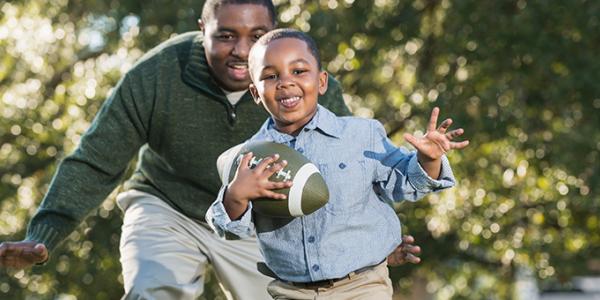Excerpt from Big Body Play: Why Boisterous, Vigorous, and Very Physical Play Is Essential to Children's Development and Learning

Families and Play
Families are eager to hear about what their children are learning. To help families understand the value of play with open-ended materials, use photos and notes to share stories of their children’s activities and discoveries. Discuss these items at drop-off and pickup times, send them home, or include them in a portfolio or at a parent conference. Create documentation displays in your classroom or hallway, with notes about what children are learning through their play experiences.
Invite families to join you in watching their children as they play, if even for a few minutes. Discuss what you notice:
- What seems to interest children about the materials they’re exploring—textures, shapes, colors, weight, sizes, or ways they can combine them
- How the materials support the children’s focus and purposeful learning
- What ideas the children might be investigating and what discoveries they might be making
Families are often thrilled to learn about inexpensive materials they can provide at home that will facilitate their children’s learning. Send home a bag of open-ended materials or a list of ideas for using them, such as the following. Include the questions below for parents to consider as they watch their children play.
Fur and Fabric
Offer a variety of fake fur pieces and fabric with different colors and textures, such as soft and shaggy materials and interesting animal prints. If possible, provide stuffed animals that match the prints and fur pieces. Include some brushes for your child to use with the fur.
Tubes and Balls
Collect clear plastic and hard cardboard tubes of varying widths and lengths. Give your child different kinds and sizes of balls to explore with the tubes—craft, cotton, table tennis, golf, tennis, and so on. Add containers with lids for your child to put balls in and watch them roll out.
Items From Nature
Gather a variety of seashells, pinecones, rocks, gourds, and seed pods for your child to explore, along with boxes and baskets. Your child might use the containers to sort the items or hide them.
Coaster Sets
Coasters come in all shapes and sizes and often have matching boxes that the coasters fit into.
Napkin Rings
Napkin rings are great for stacking and rolling as well as stringing when paired with lengths of ribbon.
As your child plays with the materials, notice how she uses her senses to explore and learn about them. Your child might be thinking, “What does this look, feel, sound, smell, and taste like?”
Notice how your child tries to discover how the objects work and what he can do with them. Your child might be thinking about questions like these:
- What can this do?
- What can I do with this?
- How do these things work together?
- How can I use this to connect with other people?
Imitate what you see your child doing to show her you that you see her ideas. Your attention tells your child that her actions have value and will encourage her to keep exploring and acting on her ideas.
Use new words and phrases to describe what you see your child doing and what he seems to be thinking. This will help build his vocabulary.
From Big Body Play: Why Boisterous, Vigorous, and Very Physical Play Is Essential to Children's Development and Learning, by Frances M. Carlson. Copyright © 2011 by the National Association for the Education of Young Children.
Learn more about this book
Resources
Recommendations
For Authors & Photographers
Catalog
Webinars
NAEYC Books List
